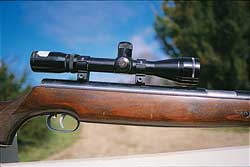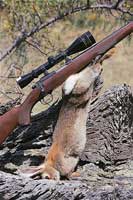Scope selection
by John Dunn
Australian Shooter December 2000
John Dunn gives some good advice on choosing a scope for an air rifle or .22 rifle. Recently, a friend who is relatively new to the shooting and hunting scene asked me for some advice about telescopic sights. He specifically wanted to know what magnifications were best for the various rifles he’d bought and their intended applications, if fixed powers were a better proposition than variables and what were the best makes to buy.
 While it wasn’t hard to give him the information he needed, his inquiry made me think about the scope market in general and how confusing it might appear to someone looking at it seriously for the first time.
While it wasn’t hard to give him the information he needed, his inquiry made me think about the scope market in general and how confusing it might appear to someone looking at it seriously for the first time.
The range of scopes available is huge, varying in both quality and price. Realistically, that means a buyer only gets what he pays for, though the gap between worst and best has narrowed significantly in the past 20 years. In an age of consumer awareness and protection, most buyers have a pretty good idea of what they want or need. Products have to be good to survive in the marketplace. Performance is important, as is value for money - two key factors that all manufacturers and distributors are very much aware of.
While everybody has their own priorities when it comes to choosing a scope, I believe there are three considerations that have to be addressed: the cost, the type of firearm the scope will be attached to and where and under what conditions that firearm is most likely to be used.
How much will it cost?
We all have to work within budgets. While we can aspire to own a scope from the top end of the market, the reality is we can usually get by with something less. That means buying the best scope you can afford at the time. You can always upgrade later.
If your heart is really set on one of the ‘name’ scopes, shop around. At times they can be picked up at discounted prices, especially at gun shows or arms fairs. Sometimes they’re offered through the Shooter’s Gallery section of this magazine, or you may pick one up through fellow shooters on the range or within your hunting club. Just be aware that a secondhand scope doesn’t come with a warranty. If you get a dud, you’ve done your money.
What type of firearm will the scope be fitted to?
Though all scopes have common features and may even look alike, the fact remains that just like oils, scopes ain’t scopes. A quick flip through a collection of catalogues will reveal just how many different types are available. They’re designed and built especially for various firearm types. There are fixed power scopes and variables. There are standard scopes and compact scopes with different diameter tubes, objective lenses, parallax adjustments, mounting requirements, lengths of eye relief and reticle styles. Some are designed purely for fieldwork while others are made specifically for range or target work. Consequently, matching a scope to a particular firearm is important.
While a scope designed for one type of firearm can often be fitted to a different type and made to work, at the end of the day it makes more sense to fit the proper scope to start with. Talk to your dealer about your needs or to other shooters who have interests similar to yours. Weigh up their advice and make an informed decision. In the long run it will probably save you money - and the frustration of less-than-expected performance on the range or in the field.
Under what conditions will the scope be used?
Most scopes are designed to do a specific job. That’s why the range available is as broad as it is. Knowing where a firearm and scope combination will be used is therefore important when making a selection.
There are no hard and fast rules about what scope magnification or type is best suited to any particular firearm or calibre. Generally, the choice comes down to using a little bit of common sense. That means selecting a scope that will meet your everyday shooting requirements most of the time - not one that might be ideal for a set of shooting circumstances that could never occur.
Scopes for air rifles
Often regarded as little more than toys, air rifles nevertheless have some special requirements when it comes to scopes. Though underpowered by rimfire or centrefire standards, both spring piston and gas spring air rifles have a unique, two-stage recoil.
When the rifle is fired there is a backward recoil effect that is immediately followed by a snapping forward motion. Combined with the vibrations produced by powerful springs, this places enormous stress on both scope and mounts, even though the felt recoil is negligible.
Scopes designed for air rifles have their lenses and reticule braced front and rear to ensure recoil doesn’t shake them loose. Scopes designed for rimfire and centrefire rifles are generally only braced at the rear; just one reason why even good quality scopes will eventually be rattled to pieces when mounted on an air rifle.
On top of this, air rifles are generally sighted in for relatively short distances, perhaps as little as ten metres. Many scopes won’t focus that closely, especially fixed powers - one of the main reasons that the majority of air rifle scopes have adjustable objective lenses.
Linked to short-range use is the relatively high trajectory that air rifle pellets have between muzzle and target. This demands an elevation bias that gives more up than down adjustment and does away with the need to shim mounts to gain the elevation required to make the shots print to the designated point of aim.
Finally, air rifle scopes require air rifle mounts. Such mounts generally have recoil stops built in to prevent the mounts from shifting. And, though it should go without saying, scope rings must be properly tightened with a properly fitting wrench or screwdriver to ensure the scope can’t slide within the rings.
Air rifle scopes are produced by a number of companies including Beeman, Tasco, Lynx, Bushnell, Simmons and Leupold - and I’ve no doubt there are others. Ask your favourite dealer what catalogues he has available. Air rifle scopes range from simple fixed power models through to quite expensive variables such as the Beeman Bushnell 6-24X 40mm, which was obviously designed for silhouette and target work.
 Scopes for rimfires
Scopes for rimfires
There was a time when any 4x scope was regarded as good enough for a rimfire rifle. For many hunters and shooters that’s probably still the case. Increasingly though, thinking hunters are learning from target shooters and recognising that a little bit more power doesn’t hurt in the field. For a general-use rimfire rifle, my preference is for a 4x or 6x scope, preferably with an objective lens large enough to provide an optimum exit pupil size.
For work over warrens or vermin shooting, where the ranges might be stretched a little, a good variable scope is a definite advantage. Here my preference is for something like a 3-9x or 4-12x, preferably with an adjustable objective lens that will focus back to about 25 metres. While the latter is not essential it does ensure a clear sight picture every time.
Also important is a maximum field of view, especially when working with the higher magnifications. A good variable also allows a rimfire to do double duty both in the field and on the range. This can mean a shooter only needs one rifle to meet his shooting interests - though range shooters generally prefer a dedicated rifle for competitive work, perhaps several if they’re shooting a number of different disciplines.
The majority of rimfire range work is about accuracy and that’s where higher-powered fixed or variable scopes come into their own. Target shooters know you can only shoot as well as you can see; that’s why fixed 24x and 36x scopes aren’t uncommon and the majority of serious competitive rimfire shooters regard 6.5-20x scopes as the norm.
Yes, such scopes do have limited fields of view, but on the range where targets are often numbered that’s not really as critical as it is in the field. Once again, adjustable objectives are essential and target turrets make a lot of sense.
Regardless of make, a fixed power rimfire scope should be parallax adjusted back to 50 yards or metres. Many variables with adjustable objectives will focus back even closer.
Every manufacturer in the business makes rimfire scopes, so the range of choices available is extensive. Using a common sense approach should help you narrow down the field, bearing in mind that you are the only person who can ultimately decide what you need.
Finally, no matter what style of rimfire shooting you participate in, appropriate mounts are just as important as the selection of a scope. As with scopes, it’s essential to buy the best mounts you can afford and make sure they’re properly fitted. The best scope in the world is no more useful than the worst if the mounts fail.
Some common scope terms
Adjustable Objective - The focusing ring on the objective lens that allows a scope to be focused from a designated minimum distance to infinity.
Elevation - Vertical adjustment of the reticle up and down.
Exit Pupil - The circle of light exiting the ocular lens. Derived by dividing the objective lens diameter by the magnification of the scope (eg, A 4x 40mm scope will have an exit pupil of 10mm. The optimum exit pupil is around 7mm.)
Eye Relief - The distance from the back of the ocular lens to the pupil of the eye when a full field of view can be seen through the scope.
Field of View - The yards or metres of country that can be seen through the objective lens at 100 yards or metres.
Fixed Power - A set magnification rating (eg, 4x, 6x, etc.).
Lens Coating - A thin layer of special material applied to glass to air surfaces of lenses to improve light transmission and contrast or to reduce glare. Many lenses are multi-coated.
Objective Lens - The front lens of a scope, the diameter of which is generally expressed in millimetres.
Ocular Lens - The rear lens of the scope. Also referred to as the eyepiece.
Parallax - The difference in the apparent position of the reticle on the target image at different ranges or an out-of-focus image. Occurs when the image of the target is not focused on the same plane as the reticle. Can be remedied with an adjustable objective. Scopes with no objective adjustment are usually set to be parallax free at designated distances such as 100 metres for a centrefire scope or 50 metres for a rimfire.
Reticle - The crosshair or aiming point within the scope. A number of manufacturers now offer scopes with illuminated reticles for improved visibility under lowlight conditions. Sometimes called a graticule.
Tube Diameter - The external diameter of the scope body, generally 25 or 30mm.
Turrets - Projections on the top and right-hand side of a scope that house graduated dials for adjusting the windage and elevation of the scope reticle when sighting in.
Variable Power - A scope with the ability to vary magnification within a set range (eg, 3-9x, 4-12, etc.).
Windage - Horizontal movement of the reticle left and right.
